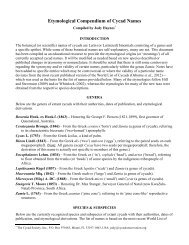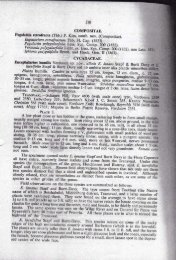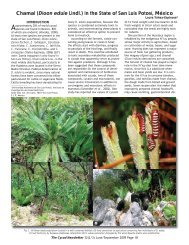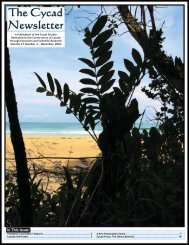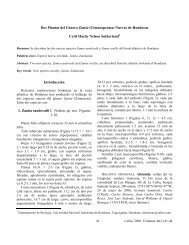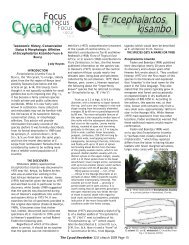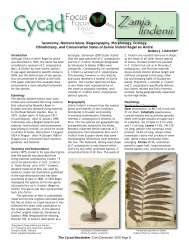In This Issue: - Cycad Society
In This Issue: - Cycad Society
In This Issue: - Cycad Society
Create successful ePaper yourself
Turn your PDF publications into a flip-book with our unique Google optimized e-Paper software.
<strong>This</strong> article was originally presented at the Second <strong>In</strong>ternational Symposium on Ornamental Palms and other Monocots<br />
from the Tropics, Tenerife, Canary Islands, 3-6 February 1997, and was subsequently published in: Acta Hort� 486, ISHS<br />
1999, pp� 123-131�<br />
PROPAGATION AND CULTURE OF CYCADS: A PRACTICAL APPROACH<br />
Bijan Dehgan and Fe Almira<br />
Environmental Horticulture Department, Horticultural Systematics Laboratory, University of Florida, Gainesville, FL 32611<br />
“<strong>In</strong> the end,<br />
We will conserve only what we love,<br />
We will love only what we understand,<br />
We will understand only what we are taught”<br />
Baba Dioum<br />
ABSTRACT� <strong>Cycad</strong>s are a geologically primitive group of threatened or endangered gymnosperms whose ancestors were widespread when<br />
dinosaurs were still roaming the earth� Today, the ±180 remaining species are restricted to specific tropical and subtropical regions of the<br />
Old and the New Worlds� Recent recommendations of the World Conservation Union (IUCN) include encouraging extensive propagation and<br />
culture of these magnificent ancient plants� Through our original research and publications in the past two decades, we have made long<br />
strides towards facilitating their commercial production� Methods of artificial pollination to ensure seed production and finding the proper<br />
treatments to expedite seed germination have been reported� Mechanical removal of the fleshy seed coat (sarcotesta), scarification of<br />
bony layer (sclerotesta) with sulfuric acid (H 2 SO 4 ), and promoting rapid embryo development by soaking in the growth regulator gibberellic<br />
acid (GA 3 ), all have collectively increased germination of several species� Root growth and branching has been enhanced significantly by<br />
decapitation of the original seedling taproot and dipping the cut end in yet another growth regulator, indolebutyric acid (IBA)� Appropriate<br />
irrigation frequency and applications of liquid and slow-release fertilizers that contain micronutrients, have resulted in exceptionally rapid<br />
growth and elimination of deficiencies� And finally, in what may be the most significant contribution towards cycad conservation, vegetative<br />
propagation has been made possible by forcing plants to branch profusely, despite absence of any lateral buds homologous to that of<br />
angiosperms and conifres� <strong>This</strong> has allowed their multiplication through division of segments� To the best of our knowledge, protocols for<br />
commercially feasible micropropagation of cycads have not been reported�<br />
<strong>Cycad</strong>s range in size from the small Zamia<br />
pygmaea Sims of about 20cm and leaves<br />
of fewer than 10 leaflets to Lepidozamia<br />
hopei Regel of about 20m and 150-200<br />
leaflets per leaf� Most are caudiciform,<br />
at least when young, and all possess<br />
pinnately compound leaves, except<br />
Bowenia spp�, which have bipinnately<br />
compound leaves� Without exception,<br />
cycads are dioecious, with male and<br />
female cones (or micro- and megastrobili)<br />
occurring on separate plants� Only in<br />
Cycas spp� do the female cones consist<br />
of loosely arranged, concentric groups of<br />
seed-bearing, leaflike structures, each<br />
having from one to as many as nine seeds,<br />
depending on the species� The seed and<br />
pollen-bearing segments of cones are<br />
referred to as mega- and<br />
microsporophylls, respectively� Both the<br />
male and the female cones of genera<br />
other than Cycas consist of tightly<br />
organized peltate (in Bowenia,<br />
Ceratozamia, Encephalartos, Microcycas,<br />
Lepidozamia, Macrozamia, and Zamia),<br />
or leaflike, overlapping, more or less<br />
triangular, palaceous (in Dioon and<br />
Stangeria) sporophylls� Unlike palms and<br />
other flowering plants, cycads do not<br />
possess an ovary and therefore lack a<br />
fruit� The seed, although resembling<br />
fruit, is said to be naked (not enclosed<br />
within an ovary)� <strong>In</strong> general, the<br />
megasporophylls of genera other than<br />
Cycas each hold two seeds� Artificial<br />
pollination and seed propagation<br />
necessitate an intimate familiarity with<br />
cones and seed structure�<br />
Nearly all cycads are endangered,<br />
threatened, or commercially exploited to<br />
excess� <strong>In</strong> some cases they nearly or<br />
completely have disappeared from the<br />
wild, either as a result of overcollecting<br />
or agricultural activities� Accordingly, it<br />
has been suggested for many years<br />
(Dehgan, 1983, 1996, Dehgan and Almira<br />
1993, Giddy 1993) and recently agreed<br />
upon by IUCN (Giddy, 1996), that if the<br />
demand for cycads is met through<br />
propagation and large scale commercial<br />
production, the decimation of wild<br />
populations by unscrupulous collectors<br />
will no longer occur� Thus, a major<br />
challenge to nurserymen and<br />
conservationists is to produce superior<br />
plants which would make collection of<br />
wild specimens unnecessary and<br />
economically unjustifiable� To<br />
accomplish this, it is necessary to discuss<br />
the needed steps in commercial<br />
production (also, see Dehgan, 1993,<br />
1996a)�<br />
The <strong>Cycad</strong> Newsletter Page 4<br />
SEED PRODUCTION: ARTIFICIAL HAND POLLINATION<br />
Seed propagation is the only practical<br />
method of large-scale, commercial cycad<br />
production� However, often seeds are not<br />
available for purchase, species planted<br />
distant from their native range cannot<br />
be pollinated because the specific insect<br />
pollinators are absent, or production and<br />
maturity of male and female cones are<br />
asynchronous� Regardless of the cause,<br />
hand pollination is requisite for maximum<br />
seed production�<br />
Often the male cone begins to shed<br />
pollen long before the female is ready<br />
for pollination� If so, collect the entire<br />
male cone when pollen first begins to<br />
shed, place on a large piece of paper<br />
(newspaper usually functions well) or<br />
paper sack (not plastic) and keep in a<br />
dry, warm location where there is no air<br />
flow� The pollen should be completely<br />
released within a few days� Collect and<br />
store the pollen in a jar together with a<br />
package of desiccant and place in a<br />
refrigerator� Properly stored pollen will<br />
remain viable for about one year�<br />
Recognizing when the female cone is<br />
ready for pollination requires more<br />
frequent observation and recognition of<br />
the signals� Cycas megasporophylls<br />
continued next page



